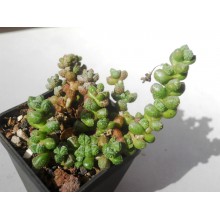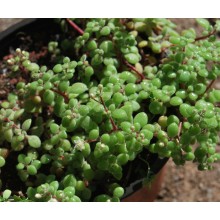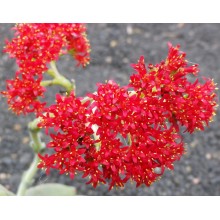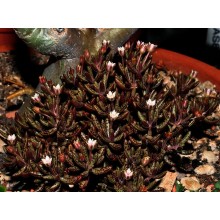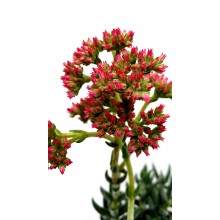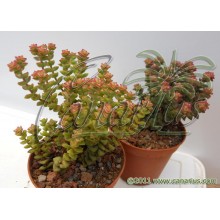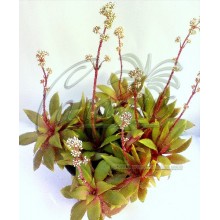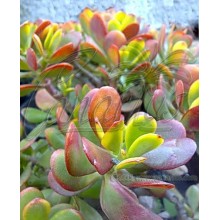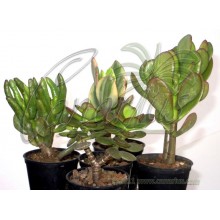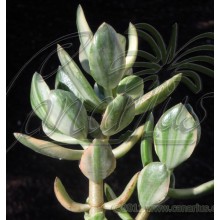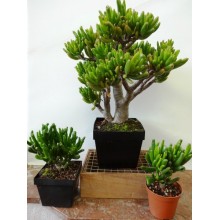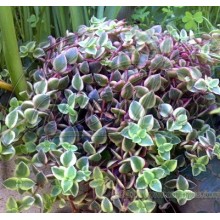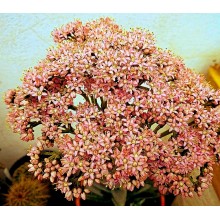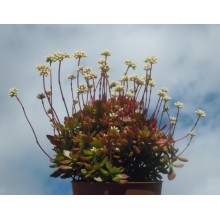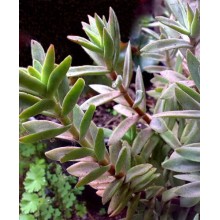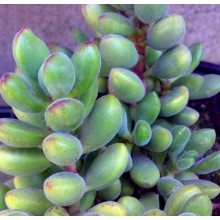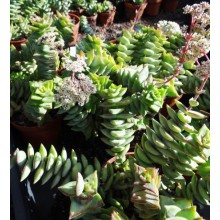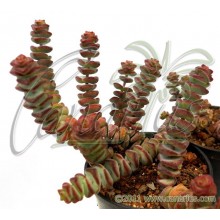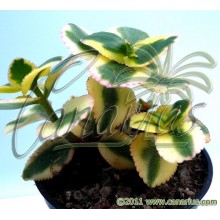Succulents There are 628 products.

World deserts and dry areas are home to the most interesting plants. Canarius offers an increasing selection of succulent plants of maximum quality, because they are grown outdoors, under the full sun of the Canary Islands.
Succulents or "fat plants" are water-retaining species, adapted to dry conditions. They store succum (juice, water) in their leaves, stems or roots, and often show a stout and fleshy appearance.
Subcategories
-
Agave
Agave is a genus of succulent plants from America. Some species grow in cold areas and take hard frost, while some others live in tropical climates. Some are tiny dwarfs and some are giants, up to 2 or 3 m wide.
Cold hardy agaves can create an exotic effect in your garden. Agave species make fine companions to palms or cacti. Variegated agaves are incredibly sought after by collectors. Our web shop offers an ever changing selection of species. We ship bare rooted plants, unless otherwise specified.
-
Aloe, Gasteria & Haworthia
Aloe, Gasteria and Haworthia are three related genera, comprising hundreds of succulent plants. They are all easily grown in pots. A few adapt to low-light levels of indoor conditions and can be grown as house plants.
- Aloe is a genus of about 400 species, native to Africa, Arabia and Madagascar. Small or dwarf aloes are becoming especially popular in colder climates as they can be taken indoors during the hardest months.
- Gasteria includes some 80 species endemic to South Africa, known for their spectacular leaves which are glossy, mottled and textured. They bloom in Spring-Summer with long spikes of small orange flowers. Some species are so variable that we offer particular clones from specific locations.
- Haworthia is a genus endemic to South Africa with about 70 species and a number of local subspecies, varieties and forms. Leaves are often banded, speckled, dotted, or semi-translucent and show wide variations.
-
Crassulaceae
This is a new, growing section of species from the family Crassulaceae. There are about 1,400 species in 33 genera and their distribution is worldwide, but mostly occur in the Northern Hemisphere and Southern Africa, especially in dry habitats. Here you can buy healthy, sun-hardened plants grown in the Canary Islands and shipped to your home.
-
Mesembs
This group of desert plants is briefly named Mesembs because they belong to a botanical family formerly named Mesembryanthemaceae. There are almost 2.000 species, mainly found in Southern Africa, with extreme adaptations to dry habitats. Some are called "living stones", as they look like pebbles. Many are easy to grow and their main need is full sun. Some are difficult because they grow in truly extreme areas.
Our Web Shop offers sun grown healthy plants, with compact and colourful leaves. Some plants are sold as cuttings, and others as rooted plants, of at least two years old.
-
Sansevieria
Recently assigned to the family Asparagaceae, the genus Sansevieria counts about 70 species, nearly all native to Africa, Arabia and Madagascar. Perennial herbs adapted to dry habitats with stiff, succulent leaves, their length ranges from a few centimeters to 2 meters. Sansevieria trifasciata and its many cultivars are among the most popular houseplants, popularly called mother in law's tongue. A well grown plant usually produces a spike of many white, richly scented flowers and then orange berries. Even the rarest species are resistant to neglect, provided you keep them from frost in winter and scorching sun in summer.
-
Hoya
Hoyas are twining vines, with showy exotic flowers, from the rainforests in Asia and Oceania. Most species grow in bright shade or morning sun, but they will also grow indoors as house plants. They are well suited for baskets, trellises or ladders. They tolerate a few weeks of drought but they are sensitive to frost and cold. Many hoyas are easy to grow and bloom, while some are tricky and rare.
-
Asclepiads
Asclepiads or Asclepiadoideae are a subfamily in the Apocynaceae, with about 2900 species. There are lots of leafless stem succulents but also perennial herbs, shrubs, lianas or rarely trees. They produce remarkable flowers, for the complex mechanisms they have developed for pollination. Many species produce an unusual fragrance, often called "carrion", and attracts flies for pollination. -
Caudiciforms
These plants from dry areas produce an unusually thick stem, the caudex. They are also called pachycauls and they have a disproportionately thick trunk, often with few branches. The caudex can be hidden underground, but in most cases they grow upwards, forming spectacular trees. The largest caudiciforms in the world are the baobabs. -
Other succulents
Here you will find all those species of desert plants that are not included in their own category. We will place here all plants from unusual families, other than Agaves, Aloes, Crassulaceae, Sansevieria, Mesembs, Epiphytic cacti, etc.
-
Crassula expansa ssp. fragilis
Crassula expansa ssp. fragilis
Tiny crassula with rounded hairy leaves on decumbent branches becoming slightly woody at base. Crassula expansa subsp. fragilis is native to So.Africa to Tanzania and Madagascar. It can be grown as a creeper or mat-forming succulent.
10,80 € -
Crassula falcata
Crassula falcata
This South African crassula makes a perfect potted plant, in Mediterranean patios or rockeries. It has beautiful thick silvery leaves and bears showy clusters of tiny scarlet-red flowers. Keep a bit dry in winter and protect from frost.
10,50 € -
Crassula humbertii
Crassula humbertii
Branched plant - Uncommon small species from Southern Madagascar, with a low branching and creeping habit. It is colourful, with purple-brownish dotted leaves.
18,20 € -
Crassula lactea
Crassula lactea
NEW ! - Pack 3 cuttings of 5-7 cm. "Lactea" in Latin means "Milky". This South African succulent bears fragrant milky-white flowers in winter, lasting several weeks. A neat branched plant with short broad leaves.
10,50 € -
Crassula mesembryanthemoides
Crassula mesembryanthemoides
Shrubby south African Crassula, with green-brown leaves densely covered with hairs and pink-red flowers. The bark peels off from the stems with age.
10,50 € -
Crassula nealeana var. nana
Crassula nealeana var. nana
Cont.= 8,5 cm. Leaves are regularly spaced on the stems, reminiscent of a necklace. Some people believe it is a form of Crsssula perforata. It stands temperatures of -5 C with little or no damage.
10,70 € -
Crassula orbicularis var. rosularis
Crassula orbicularis var. rosularis
Clumping Crassula with green flat leaves, purple on the lower face, with ciliate margins and acute tip. Terminal ascending inflorescences to 15-20 cm. The whole plant becomes more purple when stressed in hot sun or in cool temperatures.
10,50 € -
Crassula ovata cv. Hummel's Sunset
Crassula ovata cv. Hummel's Sunset
Large, branched. Rainbow coloured selection of a popular South African shrub. It is just as easy to grow as the type species.
10,50 € -
Crassula ovata mix 5 differents colours
Crassula ovata mix 5 differents colours
NEW! - Cont.= 6 cm. Five plants of different selections of Crassula ovata, with different colours and shapes.
15,00 € -
Crassula ovata Tricolor (green/white)
Crassula ovata Tricolor (green/white)
NEW! - Cont.= 8,5 cm. Variegated selection with extremely glossy striped leaves. Stripes are white but the whole plant has a jade colour.
11,50 € -
Crassula pellucida ssp. marginalis Variegata
Crassula pellucida ssp. marginalis Variegata
Three unrooted cuttings 10-12 cm. The pink, green and yellow variegated leaves make a show of this cascading South African Crassula, with hearth-shaped leaves and white flowers. Perfect for a baskets.
10,50 € -
Crassula perfoliata var. perfoliata
Crassula perfoliata var. perfoliata
Attractive Crassula with gray leaves in opposite rows and clusters of white-pink flowers occur in Summer.
14,50 € -
Crassula pubescens ssp. radicans
Crassula pubescens ssp. radicans
Dense, branched, Cont. = 8 cm - Miniature shrubby plant with small leaves turning red in full sun. It blooms for months in winter-spring, with white fragrant flowers.
10,50 € -
Crassula pubescens ssp. rattrayi
Crassula pubescens ssp. rattrayi
Crassula pubescens ssp. rattrayi grows wild in the summer rainfall areas of the Karroo desert in South Africa. It is perfect for small pots and also as a ground cover in rockeries.
10,50 € -
Crassula rogersii
Crassula rogersii
Cont. = 5 cm This Crassula grows as a branched shrublet up to 30 cm high, with slightly woody branches, upright at first and decumbent later. Stem are fleshy and leaves are covered with white hairs, short and woolly with a nice texture.
10,30 € -
Crassula rupestris
Crassula rupestris
We offer a plant of the following size: Large, branched, Cont.= 8,5 cm, tall, branched. Container size will just give you an idea of the size of the plant, because Crassulaceae are sent bare root. These plants are very tolerant of bare-rooting.
10,20 € -
Crassula rupestris subsp. marnieriana
Crassula rupestris subsp. marnieriana
- Branched plant, Cont.= 8,5 cm. Small crassula forming worm-like branches with compact small leaves coating the stems. Endemic to the Klein Karoo, in the Western Cape Province of South Africa.
10,70 € -
Crassula sarmentosa Variegata
Crassula sarmentosa Variegata
Beautiful varieagted selection of Crassula sarmentosa with creamy white stripes. Stems turn red if exposed to sunlight. The plant has a bushy/cascading habit and will eventually grow well in hanging pots or rockeries.
11,20 €
At the moment there are few products in this category Succulents

























